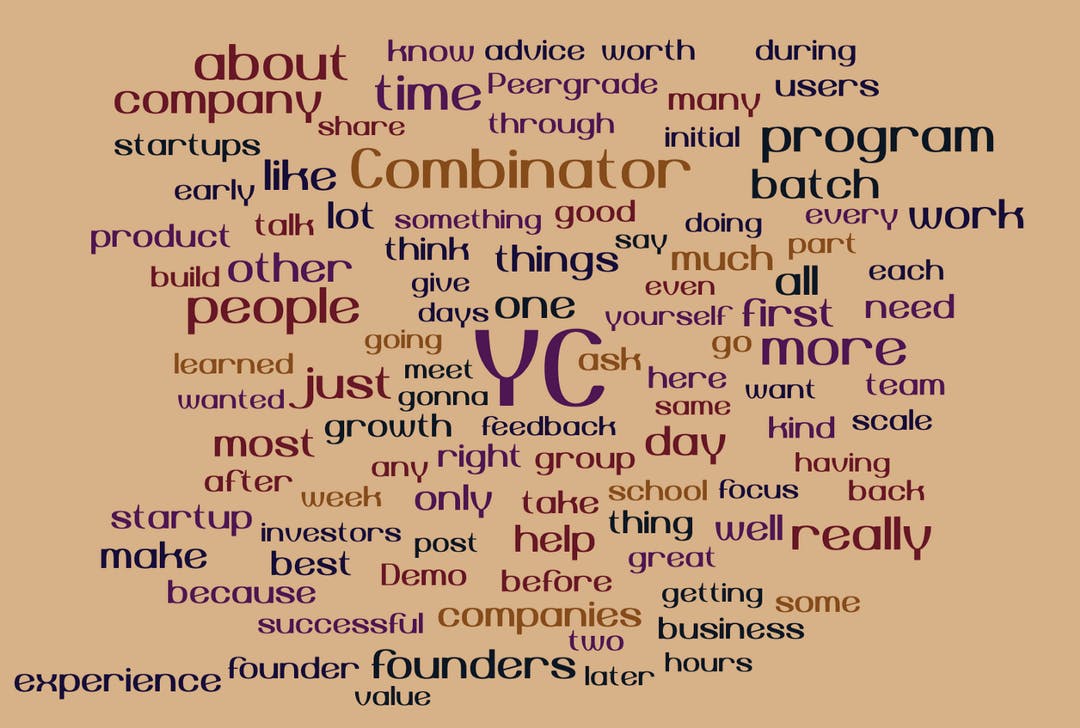Encord Blog
What I Learned From My First Month at Y Combinator

For context, I am a cofounder of Encord, a company in the current winter 2021 batch. We are focused on building software to improve data labelling for computer vision.
Before writing this I reviewed as many posts I could find(without having to go past the first page of Google) from people writing about their YC experience. There were fewer than I expected. Most people talk about interviewing and how to get in, which is probably the wider point of interest. I didn’t want this post to be redundant, so I decided to avoid talking about anything that collided with the bulk of the points from these posts, and there are many. Think of this as a second order approximation to lessons from YC.

Word cloud from previous YC posts I reviewed
First Order Lessons
I’ll go ahead and summarise the top lessons from the other posts here, but you should read them. I’ve included the list at the bottom. They are well written, and the lessons are more generally applicable than in this post. They are (roughly):
- Y Combinator is not like school, there is no set track to follow
- You get out what you put in so work hard and embrace the grind
- Think big, aim high
- Maximise your use of the resources available to you, mostly your peer and mentor networks
- Get feedback early and often from your users
- Do things that don’t scale
- Advice is often contradictory, use your own judgment
I want to dwell on the last point a little bit. My opinion is that advice should come with error bars. You have to weigh the advice you get by the distance of the advisor to your particular situation. If I asked Hafþór Júlíus Björnsson what the path to success looks like, he would probably tell me it’s in lifting weights. That would…not be the best way for me.

My startup mentor
At YC you get a lot of advice, but I find that the usefulness of advice is inversely proportional to the size of the audience that is receiving it. Advice from batch-wide events is not as relevant as what we get from our group partners in office hours. Think of the error bars as shrinking with how directed it is and also by how many times you have heard it from independent sources.
With that said, take everything I write here with error bars, large ones. The lessons are both a mix of what I have heard explicitly from YC speakers and conclusions from my own experiences during the last month. They are both abstract and actionable. They also could just be wrong.
The flip side is that most of this might be obvious. It just wasn’t to me. I could have been missing some basic stuff that it only took YC to elucidate.
Sales is Search
I don’t know why it took me so long to realise, sales is not (mostly) a persuasion problem, it is (mostly) a search problem. It is about finding the person that has the problem you are trying to solve. Ads in that sense are like autonomous search agents rather than units of persuadability.

This is not SaaS sales
As a startup you don’t have a much better search algorithm than just brute forcing it. So you need to send emails. A lot of emails. I had an idea for this before YC, but I was an order of magnitude off. Instead of sending dozens of emails a week, you have to send hundreds.
The corollary to this is that you want to make it easy for people to find you. Inbound is much more efficient than outbound from a sales conversion perspective because the person that is reaching out has already passed a bunch of filters that an outbound contact has not. This means that you should launch your product early, and launch it often. You want to give people a chance to find you.
Actionable: Get your product out there for people to easily find. Otherwise, up your email numbers by an order of magnitude.
Look for No
Time is precious, so a no is valuable. It’s why Nigerian scammers make their emails look fake. It’s because if you fall for it, you are likely gullible enough to fall for the entire scam. That saves them a lot of time wading through false positives. For a startup, a “no” both frees your time and provides a learning opportunity. It tells you what your product is missing and who your true customers are.
A “yes”, on the other hand, is not a singular event. In SaaS sales “yes” is actually a funnel of yeses(plural yeese?) that you have to elicit to eventually end in a contract. If you are not making progress moving down this funnel, then you are probably wasting your time. A “no” saves you from having to figure that out for yourself. Thus, the order of preferred customer response is: yes > no > don’t respond > maybe. Yes is best, but no is for pros.
Actionable: Try to get a commitment from customers one way or the other and don’t make your product something it is not. Accept the no and move on.
You are Boring the Customer
Clients don’t care about your product, they care about the solution to their problem. Show the clients how your product is that solution. That means listening to them.
Before this month, I was talking a lot during customer calls and demos. I was trying to show as many features as I could from the product. It is natural to do that, because you personally find it cool how you solved all the difficult problems to get these features working. You think that if you show them a bunch of neat bells and whistles, they will be more impressed with the product.
But the truth is that the customers just want to know how you can help them, and not much else. You don’t have to show them a feature that you think is awesome if it is not relevant to them. Otherwise you run the risk of boring them, which I now realise I was probably doing.
Actionable: Talk 40%* less in demos.
YC Relativity
Not much to add on the personal side over what most posts have already said. The only interesting tidbit is our relationship with time. On one side you are so busy and working such long hours that it seems like every day just drags on endlessly. On the other hand, you constantly feel like you are behind and have to catch up with everything you have to do. You are racing against the week, but it is taking forever. The most apt analogy is the feeling you get on the last 100 meters of a 400 meter sprint. You are moving the fastest you can, but you feel very slow and weighed down.
There is another related phenomenon that is akin to time dilation in special relativity, a disconnection of subjective time from calendar time. You are in a startup that is a rocket moving through “traction space”, where your subjective feeling of progress is benchmarked by changes there rather than the days of the week. The faster the ship goes, the more you become dislocated from the external contextual markers that feedback into your normal perception of time. Combining all that together and the last month has felt like a day, and a year.
Failure > Success
One thing I found from listening to all the talks is that I learn more from the stories about failure than the ones about success. Success stories are for inspiration, but failure is for education. The most effective talks are the melding of the two, where people talk either about how their failure turned into success or their success turned to failure. They give a nice A/B test over someone’s career.
The problem I have with pure success stories goes back a bit to error bars on advice. They are rare cases, likely not statistically significant and difficult to reverse engineer. It’s like trying to figure out how to get rich from talking to a bunch of lottery winners; you will probably come away with a lot of errant conclusions. Not to say people that have built great startups are only just lucky, just that I am suspicious of extrapolating lessons from them because we are not seeing the rest of the sample. A much more informative frame is to talk to a bunch of lottery players. Only then do you learn that playing the lotto is a terrible idea(like starting a startup).
The other reason is that I feel like it is easy for someone successful to mis-attribute the determinants of their own success. For one, they are probably still associated to the entity that made them successful so they might be attached to a narrative and might not have very clear incentives. There is also not that much reason for them to truly understand it, because things are working. In contrast, a smart, introspective founder that has undergone failure is under a lot more evolutionary pressure to learn from it and synthesise the experience into clear actionable lessons. Hearing about those experiences have personally been a lot more useful for guiding the trajectory of our company. When it comes to hearing a story about a startup that rocketed to unicorn land in a year versus the one that died in the garage, I’ll take the garage.
It’s a Business, stupid
People often see their startups as movements, or lifestyles, or disruptions to the status quo, or solving AI, or under some other grandiose perspective. But first and foremost, a startup is a business. That just means it should sell something that people want to buy. Like an ice cream stand. If YC has instilled one thing and only one thing in me so far, it’s the importance of looking at our company from this lens. It has been very useful to strip the pretensions around our startup and just focus on delivering a product that people want. That’s it, simple as that.
This is underscored by the concept of product market fit. This has been mentioned in other posts, but I wanted to go over it again because of how strongly it has been emphasised during the last month. I didn’t truly understand the definition before YC, now I do.
So, what is product market fit? The best description is from a paraphrase from Emmett Shear of Twitch(a YC company):
Before product market fit it feels like you are rolling a boulder uphill, after you have product market fit it’s like you a chasing it downhill.
Put differently from Dalton Caldwell(one of our group partners):
You know you have product market fit when growth is no longer you biggest problem.
Product market fit is the validation that you have created something that people actually want.
It’s so important that multiple people have described a startup as existing in only two regimes, before PMF and after PMF. I have seen it myself in talking to founders on both sides of it. Founders before PMF sound down and unconfident. After, they are hectic and frenzied, trying to figure how to keep up with that boulder. In a sense, a startup is like a manic-depressive. Before PMF it is in the depressive stage, filled with existential angst over its place in the world, not sure if it should keep going on or not. After, it is manic, trying to productively focus its flailing energy and not harm itself in the process. Your first goal as a startup is to go from being depressive to being manic.
Long Way to Go
That’s the first month. It has been quite an experience thus far, even though it has been remote. I wanted to write this post while still early in the batch so that my mental narrative of the program hadn’t been consolidated in any way by hindsight and the eventual actual trajectory of Encord. Writing in the present is foggy, but history is hindsight, and thus history is hindsight bias. It’s like someone talking about a maze from a bird’s eye view versus from within the maze itself. We are in the maze now. Hopefully we will make it out.
*Or some other significant number
Explore our products




